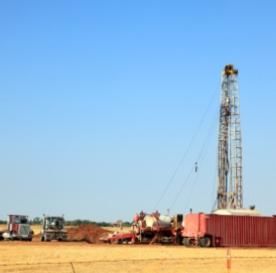
The biggest earthquake ever recorded in Oklahoma struck on November 5, a magnitude 5.6 temblor that buckled a highway and ruptured water pipes. This quake is part of a skyrocketing rise in seismic activity the state has seen in the past three years, leading many to wonder - and worry - about its cause. Might the practice of fracking, a controversial method of drilling into rock for natural gas, be to blame?
The earthquake struck around 10 P.M. local time about 50 kilometers east of Oklahoma City, and was felt from Saint Louis to Dallas. Until then, the state's largest temblor was a magnitude 5.5 event near the town of El Reno in 1952.
Overall, only minor injuries and damage were reported after last weekend's earthquake. A magnitude 4.7 foreshock preceded the quake by about 20 hours, and dozens of aftershocks were detected as well. These all apparently happened on the well-mapped Wilzetta Fault. "It seems the east side of the fault moved a bit southward," says seismologist Randy Keller, director of the Oklahoma Geological Survey (OGS).
The recent uptick in the area's temblors has been dramatic. From 1972 to 2008 only two to six earthquakes were reported per year in Oklahoma, and were often too small for people to notice. However, in 2009 nearly 50 earthquakes were recorded (pdf), and that number more than doubled in 2010 to 1,047, with 103 powerful enough to be felt.
This unusual seismicity has led some to wonder about increased activity in the area related to fracking, or hydraulic fracturing, which uses millions of gallons of fluid to break apart rock and release natural gas. The practice generates a considerable amount of waste liquid, which is often disposed of by injecting it into deep rock formations where it can lubricate faults. Hydraulic fracturing is common in Oklahoma, the nation's third-largest producer of natural gas, and has taken place there for decades (pdf). Now, with the discovery of natural gas deposits in other regions of the U.S., the extraction method is being used more widely and has raised concerns about its potential to contaminate drinking water.
Fracking has been linked to two minor earthquakes in northwest England, very likely by lubricating an already stressed fault zone and thus making it easier for the land to shift (pdf). A report in August (pdf) by seismologist Austin Holland at the OGS also suggested that a swarm of nearly 50 small quakes of magnitude 1.0 to 2.8 near the center of the state might have been triggered by nearby fracking.
Still, researchers say it seems unlikely that fracking had anything to do with last weekend's magnitude 5.6 quake. "There was a lot of deformation of the Earth here 300 million years ago that created huge geological structures in the subsurface that shift from time to time," Keller says. "We have an unstable situation here, and it's one reason why oil and gas is available here in the first place."
Comment: Interesting statement. If read a certain way, it seems to indicate admission that oil and gas are not so much fossil fuels, but something formed deep inside the earth, slowly leaking to the surface in earthquake-prone areas around the globe. Consider this statement in the context of these articles:
Can oil form without organic matter?
Titan Has More Oil Than Earth
"I won't say that man's activity never ever caused the release of seismic stress, but hydro-fracks are such small things," Keller adds. "If we were talking a magnitude 1 or 2 earthquake, that'd be different, but it's awfully hard to imagine a hydro-frack being involved with one of this size. We also have to determine if there were any frack jobs going on there right now, but I don't think there were - it didn't happen in an area of particularly active oil and gas exploration."
As to whether the spike in earthquakes recently seen in the state might be due to fracking, "it is probably best not to attach much significance to perceived increases in seismic activity in Oklahoma - the occurrence of earthquakes anywhere is quite irregular," says seismologist Art McGarr with the U.S. Geological Survey. This surge in quakes might be a temporary statistical anomaly.
"It may be, however, that more earthquakes are being induced in Oklahoma because of an increase in disposal well operations and, indeed, research is going on now to investigate this possibility," McGarr says. The large amounts of fluid disposed of in this way can seep into cracks and lubricate already stressed faults, making it easier for them to slip and cause an earthquake." No answers yet, however."
Scientists had three or four seismographs positioned at the epicenter of the earthquake when it occurred, and another 25 to 30 will be deployed there now or soon to study aftershocks and locate the November 5 quake's origin more precisely. "In a few weeks or a month we may have a better idea of what might have caused this earthquake sequence - natural tectonic processes or industrial activities," McGarr adds.



Probably NOT, Mr. Choi?
Scientific American and this author must be shilling for oil drillers too. There is no question that fracking increases seismic activity. The evidence, not just in Oklahoma, but in Arkansas and even the UK (where it's been banned) for heaven's sake, is overwhelming.